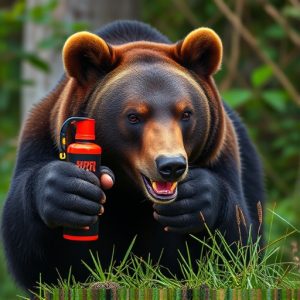Mastering Bear Spray: When, How, and Additional Wilderness Safety
Understanding when to deploy bear spray (a specialized chemical deterrent) is crucial for wilderness…….
Understanding when to deploy bear spray (a specialized chemical deterrent) is crucial for wilderness safety. It should be used as a last resort during defensive or aggressive bear encounters, aiming for the face and eyes at 20-30 feet distance. Proper usage involves recognizing predatory behavior, maintaining distance, and respecting the bear's space. Choosing the right concentration based on bear species and intended use is essential. Bear spray complements safe hiking practices like noise-making, food security, and awareness, with prevention being the primary focus.
“Enhance your wilderness safety arsenal with bear spray—a powerful tool for deterring aggressive bears. Understanding how and when to deploy this equipment can significantly improve your outdoor experience. This article guides you through the intricacies of bear spray, from its chemical composition and deployment techniques to choosing the right fit for your adventures. Learn about threat recognition and proper usage to ensure maximum efficacy in real-world scenarios. Discover additional safety measures beyond spray to create a comprehensive wilderness preparedness plan.”
- Understanding Bear Spray: What It Is and How It Works
- When to Deploy Bear Spray: Recognizing Threat Levels
- Proper Usage Techniques for Maximum Efficacy
- Choosing the Right Bear Spray for Your Needs
- Beyond Spray: Additional Wilderness Safety Measures
Understanding Bear Spray: What It Is and How It Works
Bear spray is a powerful tool designed for self-defense against bears in wild environments. It’s more than just a repellent; it’s a specialized chemical agent that creates a barrier between you and the bear, enabling you to retreat safely. When faced with an aggressive bear, spraying this substance can deter an attack by temporarily blinding and disorienting the animal.
The key to effective use lies in understanding when and how to deploy it. Bear spray should be used as a last resort when a bear exhibits predatory or defensive behavior. It’s crucial to recognize the appropriate signs, such as charging, growling, or clenching its jaws. Proper application involves aiming for the bear’s face and eyes, creating a dense cloud of spray to ensure maximum impact and distance from the potential threat.
When to Deploy Bear Spray: Recognizing Threat Levels
When to Deploy Bear Spray: Recognizing Threat Levels
Knowing when to use bear spray properly is crucial for ensuring wilderness safety. The decision to deploy bear spray should be based on understanding threat levels, which can vary greatly in different environments. If you encounter a bear from a distance and it shows no signs of aggression, simply backing away slowly may be enough to avoid conflict. However, if the bear approaches within close proximity or displays aggressive behavior like growling, snarling, or raising its head and shoulders, using bear spray becomes increasingly necessary.
Proper deployment requires aiming for the bear’s face and eyes, creating a barrier that disorients it long enough for you to retreat safely. It’s important to remember that bear spray is not a foolproof solution; proper usage depends on maintaining distance and respecting the animal’s space. By recognizing threat levels and using bear spray appropriately, adventurers can significantly enhance their safety in bear country.
Proper Usage Techniques for Maximum Efficacy
When to Use Bear Spray Properly
Bear spray is a valuable tool for wilderness safety, but its effectiveness hinges on proper usage techniques. It’s crucial to understand when and how to deploy it. The ideal time to use bear spray is during encounters where a black bear or grizzly bear exhibits defensive or aggressive behavior, such as charging, growling, or swatting at you with its paws. Aim for the bear’s face and eyes, as these areas are sensitive, ensuring a direct hit. Spraying from a distance of 20 to 30 feet (6 to 9 meters) is optimal, allowing for maximum coverage without blowing back towards you.
Avoid using bear spray as a preventative measure or as a substitute for safe hiking practices. It should only be deployed when you’re in immediate danger. Additionally, ensure your can is properly maintained and inspected before each trip. Check expiration dates, inspect the seal, and make sure the nozzle isn’t blocked. Regularly cleaning and storing it appropriately will guarantee its readiness when you need it most.
Choosing the Right Bear Spray for Your Needs
When considering bear spray as part of your wilderness safety gear, it’s crucial to choose one that suits your specific needs and intended use. Bear sprays come in various strengths and can differ in terms of range, concentration, and application method. For instance, if you’re primarily hiking in areas with black bears, a lower concentration spray might be sufficient. However, for activities involving grizzly bears or those requiring longer protection ranges, opt for higher strength formulas.
Proper usage is paramount when employing bear spray. It should only be used as a last resort when faced with an aggressive or defensive bear encounter. The spray creates a barrier of capsaicin, temporarily distracting and deterring the bear. Aim for the bear’s face and eyes, keeping in mind that wind direction can significantly impact effectiveness. Remember, early detection and avoidance are key; bear spray should be seen as a backup solution to prevent close encounters.
Beyond Spray: Additional Wilderness Safety Measures
When to Use Bear Spray Properly: Beyond Just a Defense
While bear spray is an invaluable tool for wilderness safety, it’s not a magic solution. It should be used as part of a comprehensive strategy when venturing into bear country. Always carry and know how to use it, but also understand the limitations. Not all bears will react to spray, especially if they are surprised or protecting their young. Therefore, it’s crucial to make noise while hiking to prevent unexpected encounters.
Other safety measures include staying in well-traveled areas, securing food properly, and knowing local bear behavior patterns. Carrying a whistle for emergencies and learning basic bear awareness techniques can significantly enhance your safety. Remember, prevention is key; spray should be a last resort when facing an aggressive bear.
Bear spray is a valuable tool in your wilderness safety arsenal, but its effectiveness depends on understanding when and how to use it properly. By recognizing threat levels and employing the right technique, you can enhance your chances of staying safe during encounters with bears. Remember, while bear spray isn’t a guarantee of protection, it can be a game-changer in potentially dangerous situations. Always choose a suitable spray for your needs and consider it as part of a broader safety strategy when venturing into wilderness areas.


